Do you know what kinds of plants are native to Hawaii? If not, then you’re in for a surprise! Many beautiful and unique plants grow naturally in Hawaii, and it’s worth taking the time to learn about them.

Let’s highlight some of the most interesting native plants in Hawaii.
1. Pua Kala (Argemone glauca)

The Pua Kala plant can be dried, boiled, or cooked as a vegetable and is an essential part of traditional medicine.
©RukiMedia/Shutterstock.com
Pua Kala is known for its distinctive appearance, with spiny, silvery-green leaves and large, white flowers. The flowers have a delicate, papery texture and bloom in the spring or early summer. In the fall, the plant produces small, black, or dark brown seeds that are dispersed by the wind.
Once mature, it can grow up to 4 feet. Due to its prickly leaves, you should wear garden gloves when handling them. Pua Kala prefers a dry climate and thrives in rocky and sunny areas.
The humble Pua Kala (Argemone glauca) is much more than meets the eye. A poppy variety that is only native to Hawaii but found in many gardens worldwide, Pua Kala has numerous medicinal properties and uses that are becoming increasingly known by modern science.
The plant can be dried, boiled, or cooked as a vegetable and is an essential part of traditional medicine that has been used for centuries to treat stomach illnesses and several other ailments like toothaches and nerve pain.
Studies also suggest that certain parts of the plant could be used to synthesize drugs which means it could have a bright future in medical research too!
All this shows that while it may often be overlooked and misunderstood as a common weed, Pua Kala has plenty to offer.
2. ‘Aiakanene (Coprosma ernodeoides)

Aiakanene is an evergreen shrub, making its presence especially valuable in reforestation areas as a natural addition to the local flora.
©Sundry Photography/Shutterstock.com
‘Aiakanene, or Coprosma ernodeoides, is a Hawaii native bush species that looks like a common shrub and grows up to 8 inches (20 cm). Its multiple short branches are covered in small, leathery leaves.
‘Aiakanene loves wet areas and thrives near streams or in gullies and forests, where its bright yellow-green flowers bring some cheer to the environment. Once the flowering season has ended, these are replaced with glossy black tiny fruit which native birds love to eat.
‘Aiakanene is an evergreen shrub, making its presence especially valuable in reforestation areas as a natural addition to the local flora.
It has occasional medicinal uses in traditional Hawaiian medicine, including using it as a laxative. So, although edible, unless you are having digestive issues, it might be best to avoid trying its tasty-looking berries.
One of the unique characteristics of Aiakanene is its ability to tolerate a wide range of conditions. It can grow in both sunny and shaded areas and can withstand drought conditions as well as periods of heavy rainfall. This makes it a popular choice for gardens and landscaping in Hawaii.
3. Kou (Cordia subcordata)
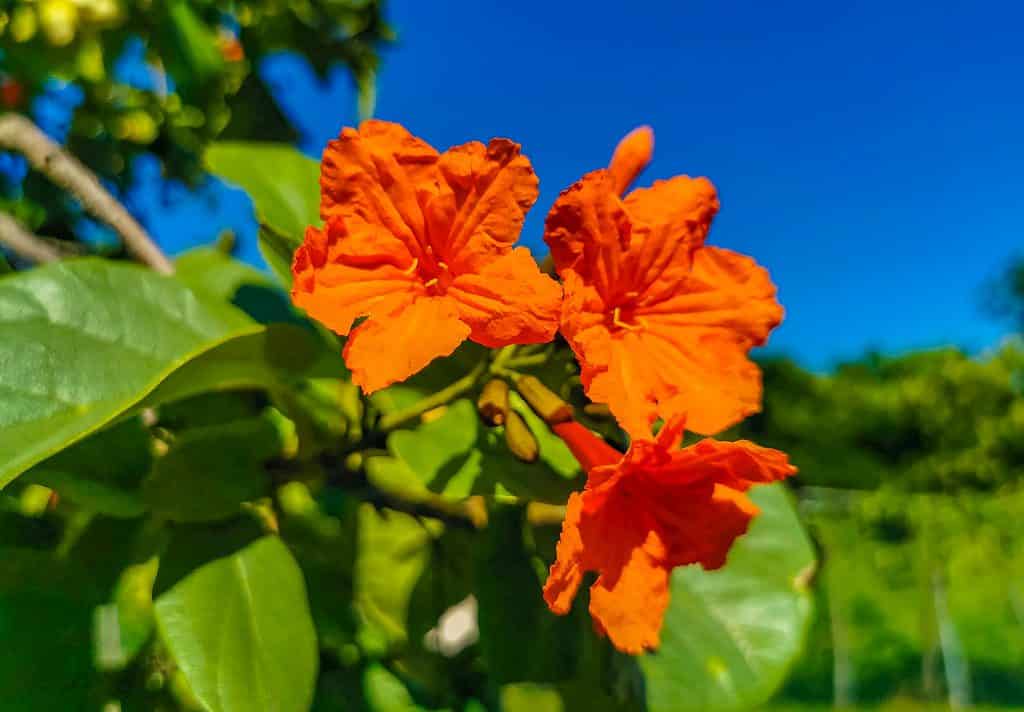
Kou has dark green, oval-shaped leaves that are glossy and smooth to the touch.
©Arkadij Schell/Shutterstock.com
Kou, also known as Cordia subcordata, is a small tree native to the Pacific Islands and parts of Asia and Africa. Thanks to its attractive appearance and hardy nature, it is a popular choice for gardens and landscaping in these regions.
Kou has dark green, oval-shaped leaves that are glossy and smooth to the touch. The tree produces small, orange flowers all year round.
One of the key characteristics of Kou is its ability to tolerate a wide range of conditions. It can grow in both sunny and shaded areas and is able to withstand both dry and wet conditions. Above all, Kou is salt, drought, and wind tolerant.
As one of Hawaii’s most prominent trees, it makes quite the statement with its exceptionally large and glossy leaves that can measure up to 7 inches in length!
The bark of the Kou is even said to have therapeutic properties when applied directly to skin ailments.
Overall, Kou is a fascinating tree that goes beyond being a beautiful addition to any landscape – it will add charm and character to its surroundings.
4. Hinahina (Geranium cuneatum)
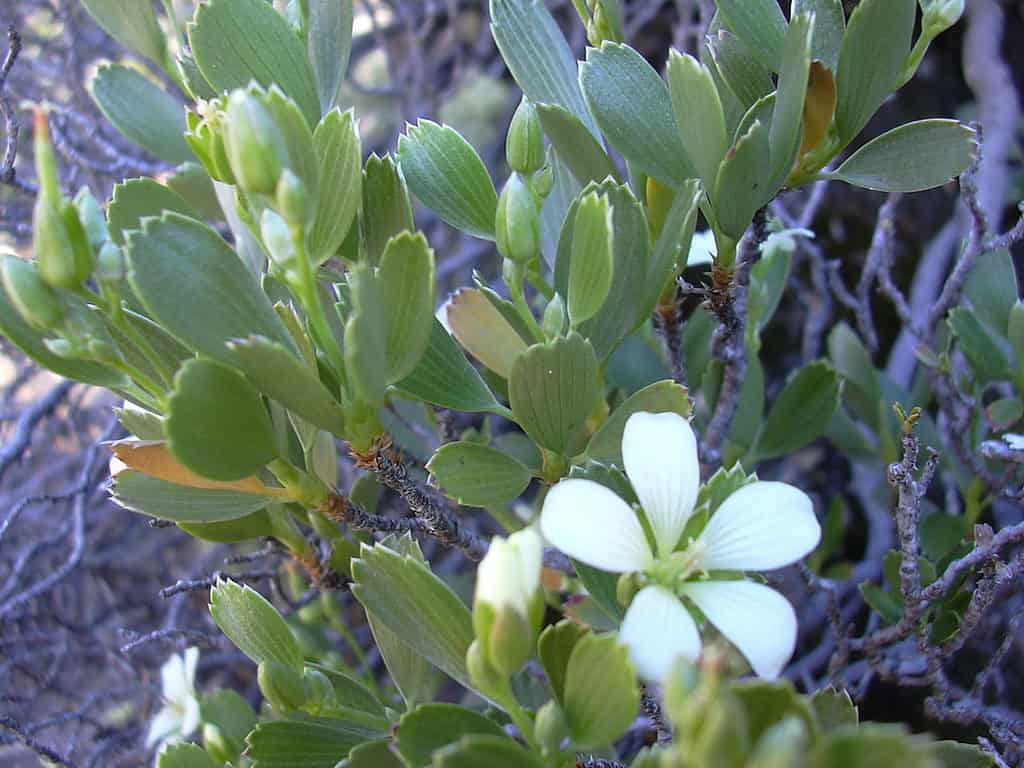
If you are looking for a low-maintenance plant, this one is for you, as Hinahina will thrive in most conditions with little care.
©Forest & Kim Starr / CC BY 3.0 – License
Hinanhina, also known as Geranium Cuneatum, is a small, perennial plant that is native to Hawaii and New Zealand. Hinahina has small, deeply-divided leaves with a dark green color on the top and a lighter green on the bottom. The plant also produces small, white flowers that bloom in the summertime.
If you are looking for a low-maintenance plant, this one is for you, as Hinahina will thrive in most conditions with little care.
Its long narrow thready stems can help stabilize loose dunes and stabilize soils against erosion. For the Native Hawaiian people, however, the scent of this hardy flower symbolizes remembrance of those who have passed away.
5. Ma’o Hau Hele (Hibiscus brackenridgei)
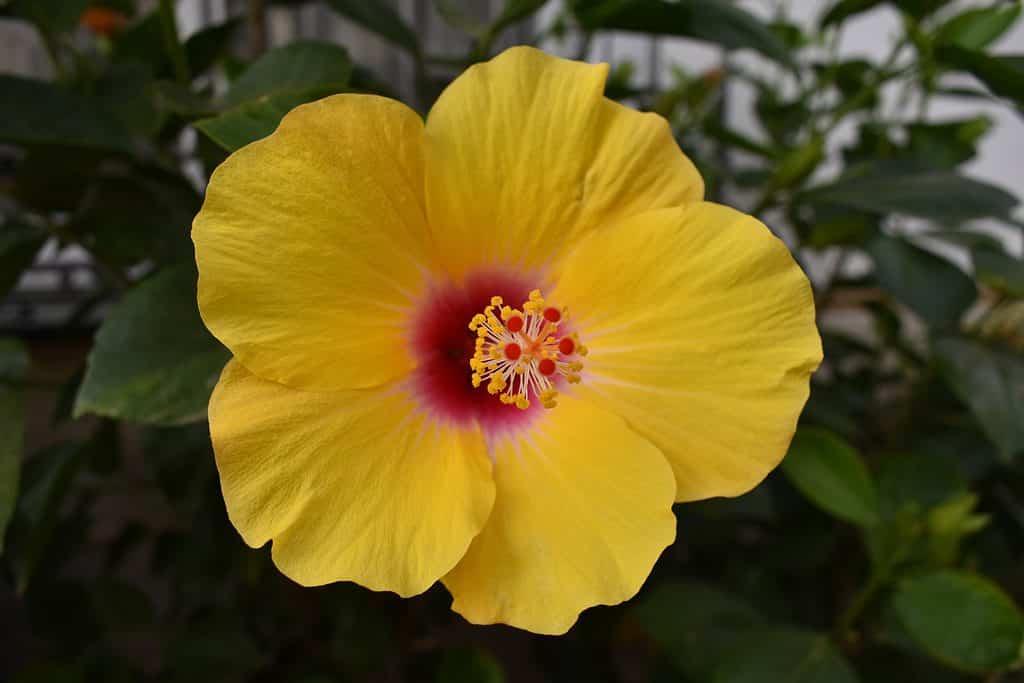
Ma’o Hau Hele grows as a shrub, typically reaching heights of around six feet at the start.
©Olga S photography/Shutterstock.com
Ma’o Hau Hele is an endangered hibiscus species that can only be found in the wild in Hawaii. It rises above other Hawaiian plants and can grow over 15 feet tall.
Ma’o Hau Hele grows as a shrub, typically reaching heights of around six feet at the start. It has large, glossy leaves and produces flowers that are usually yellow in color, with a red center. These flowers can be up to eight inches in diameter, making them some of the largest hibiscus flowers in the world.
In addition to its versatility, Ma’o Hau Hele is also known for its cultural significance in Hawaii. It is often used in lei making, and its flowers symbolize the Hawaiian Islands. Overall, Ma’o Hau Hele is a beautiful and versatile plant that is an integral part of Hawaiian culture.
Unfortunately, it has been on the brink of extinction for decades. It was thought to be completely wiped out in the late 20th century until it was rediscovered and propagated at the Waimea Arboretum.
Today, programs have been established devoted to its conservation and preservation, and projects have put into place a plan for reintroducing this unique species into Hawai’i’s ecosystems. There is great hope that Ma’o Hau Hele can find success after so many years of disappearance from its rightful home.
6. Blue Morning Glory (Ipomoea indica)
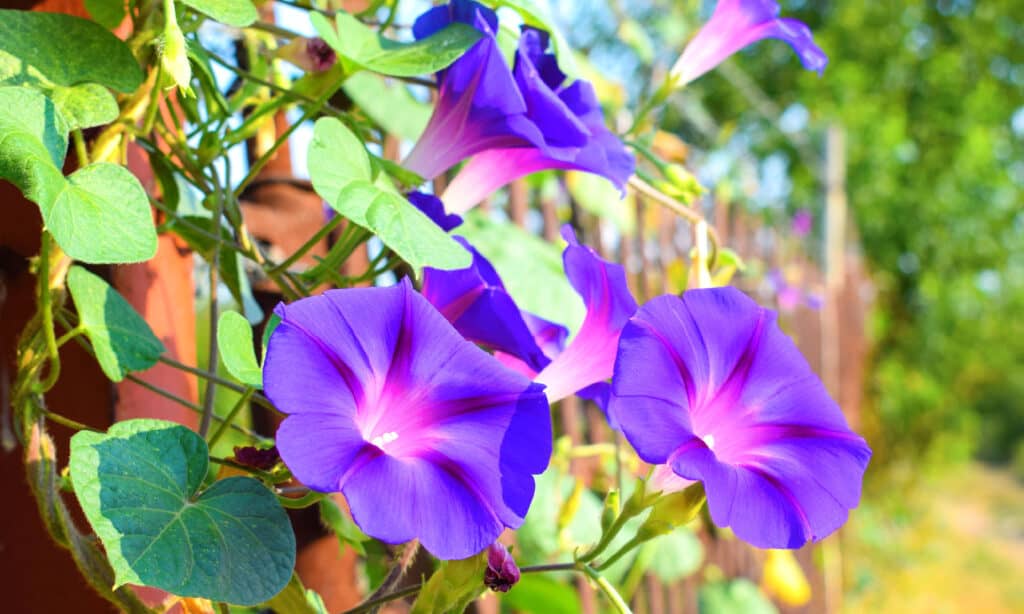
Blue Morning Glory grows as a vine, typically climbing trellises or other structures.
©iStock.com/Wakhron
Blue Morning Glory, also known as Ipomoea Indica, is a flowering plant native to the tropical regions of the Americas, including Hawaii. It is a member of the morning glory family and is known for its attractive, trumpet-shaped flowers.
Blue Morning Glory grows as a vine, typically climbing trellises or other structures. It has heart-shaped leaves and produces flowers that are blue or purple in color. These flowers can be up to four inches in diameter and have a delicate, almost translucent appearance.
This plant has become popular to cultivate at home because of its easy care requirements; moderate temperatures and spaces with partial sun exposure are perfect for the Blue Morning Glory. With proper care, the flowers can bloom consistently during the summer and throughout the fall months.
This beautiful flower is visually striking and has many medicinal benefits. Traditionally, the juice from the leaves was used to treat anemia and digestive issues. In modern times, it’s believed to strengthen heart health and improve circulation. No longer confined just to gardens and parks, this versatile and bold bloom has become popular among florists due to its beauty and fragrance.
With such a wide array of advantages, it’s no wonder the Blue Morning Glory remains one of nature’s most celebrated gifts!
7. Hala (Pandanus tectorius)
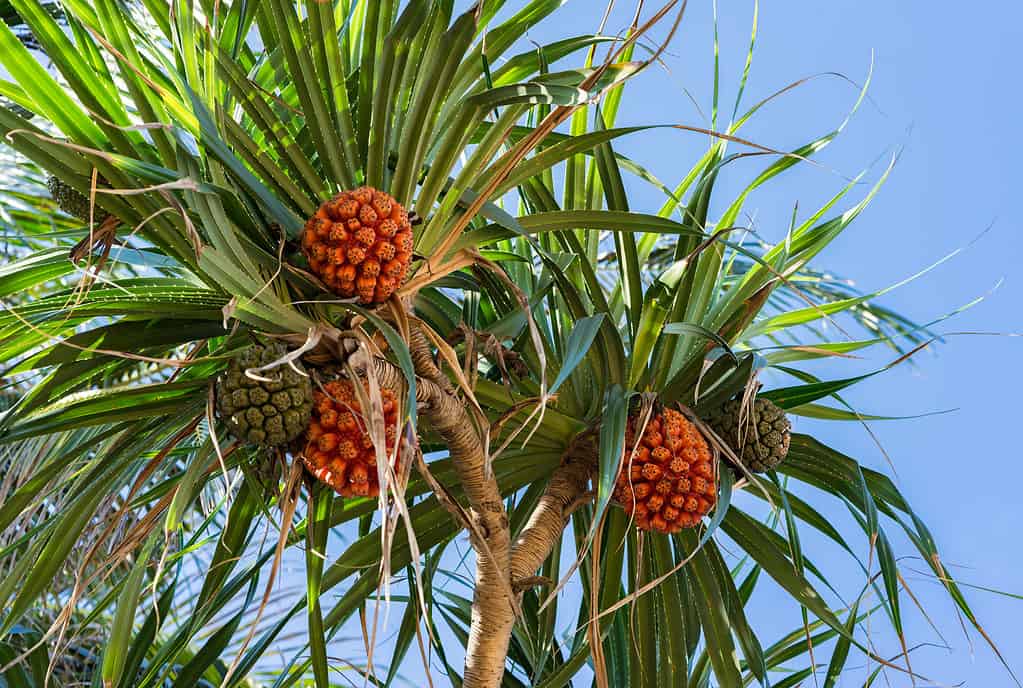
Hala can easily reach heights of around 30 feet with a spread of around 20 feet.
©Evgeny Drablenkov/Shutterstock.com
Hala is a tree that can be found in tropical and subtropical regions of the world, including Hawaii. It is a type of palm tree with thick, multiple trunks that produce sharp, strong leaves perfect for shaping into baskets.
Hala can easily reach heights of around 30 feet with a spread of around 20 feet. It has long, sword-like leaves that grow in a spiral pattern around the tree trunk. The leaves are typically green but can also be yellow in color. The tree also produces small, inconspicuous flowers that are followed by edible fruits.
Since ancient times, these trees have been used by communities around the world to create elegant mats, attractive hats, bags, and even fence posts. The stem fibers of the Hala provide valuable materials for many different cultures around the globe and showcase humankind’s enduring relationship with nature.
The beautiful diamond-shaped fruit of the Hala tree can be enjoyed raw, dried, or cooked, and its blossoms have been used to make leis, mats, and clothing. In Hawaii, the leaves of the Hala tree have been used as roofing material with stitches that last hundreds of years!
A true representation of its versatility, the Hala truly is an amazing plant species that deserves more attention than it gets.
8. Ohelo ‘Ai (Vaccinium reticulatum)
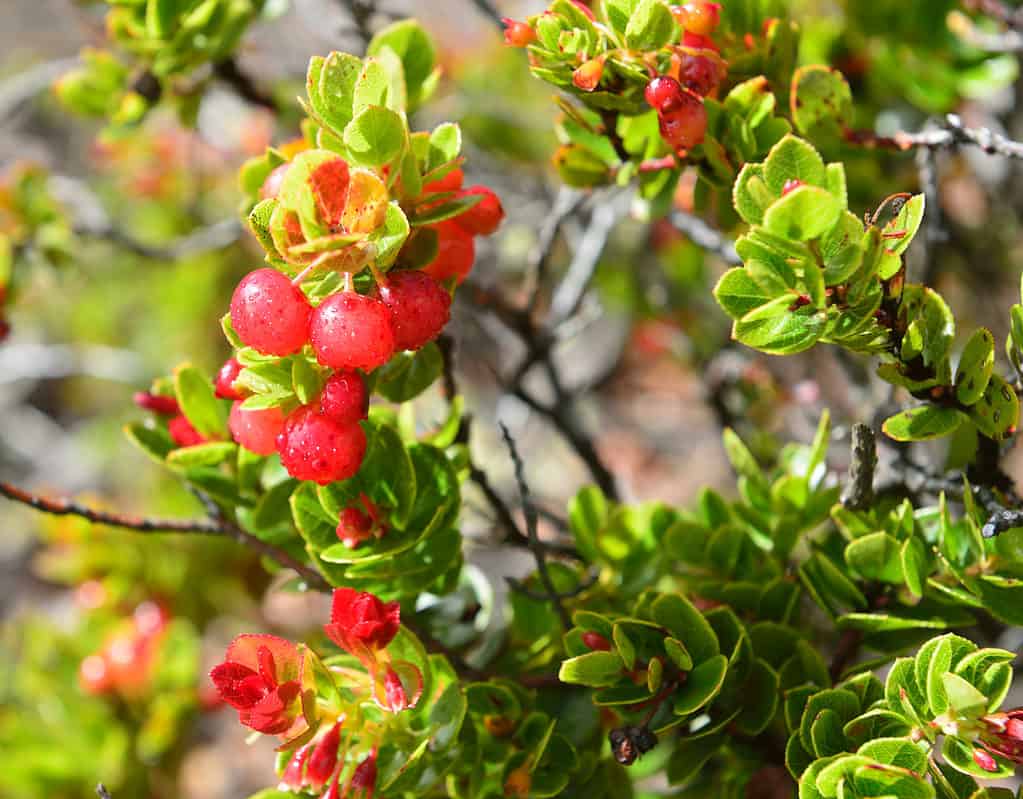
Ohelo’ ai grows as a shrub, typically reaching heights of around 3 to 4 feet.
©Alexey Kamenskiy/Shutterstock.com
Ohelo’ ai, also known as Vaccinium Reticulatum, is a small shrub that is native to the Hawaiian Islands. It is a member of the blueberry family and is known for its small, edible fruits. It is found growing in high altitudes, colonizing new lava flows.
Ohelo’ ai grows as a shrub, typically reaching heights of around 3 to 4 feet. It has small, oval-shaped leaves that range in color from dark green to yellow. New leaves are red in color. The shrub also produces small, white flowers that bloom in the springtime. These flowers are followed by small, round fruits that are typically red or orange when they are ripe.
This plant has long been used by Hawaiians in making preserves and jellies, as the high amount of pectin in the berry helps it to easily thicken. Ohelo’ Ai provides a unique flavor that can be found nowhere else and is now used in popular jams, sauces, and other forms of food preparation around the world.
This berry’s unique flavor has made it highly sought-after across Hawaii and beyond, as its presence has grown due to increased cultivation and popularity.
Not only is it tasty, but Ohelo’ Ai also offers numerous health benefits, such as providing hydration during recovery after exercise as well as helping with digestion due to its high levels of dietary fiber.
9. Hapu’u Pulu (Cibotium glaucum)
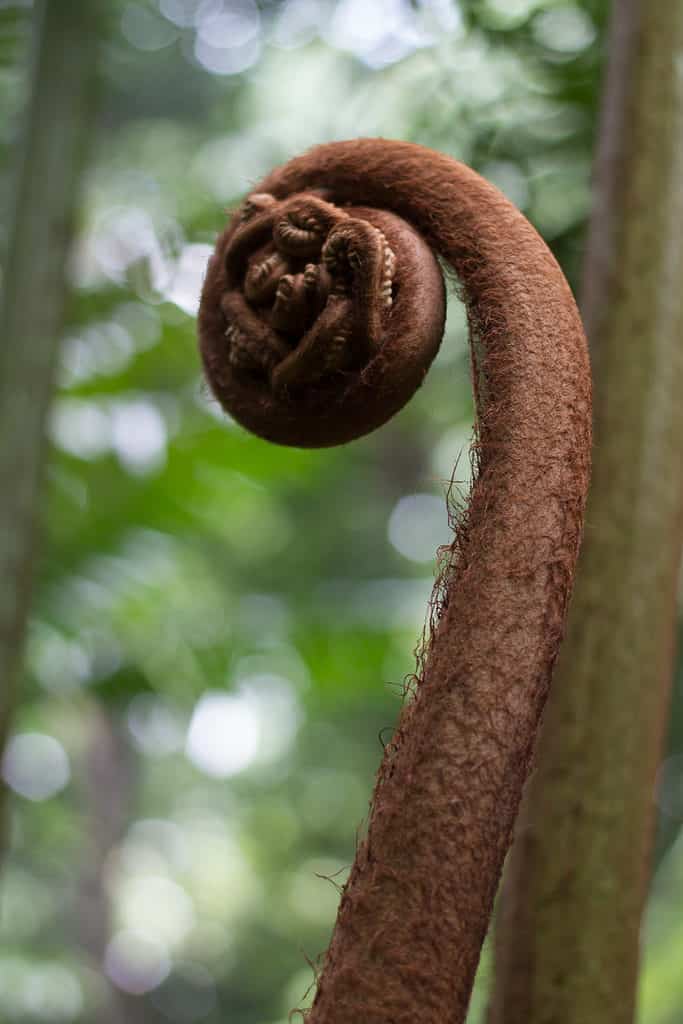
This fern species has long, glossy fronds that emerge from a central trunk.
©Robin Prananta/Shutterstock.com
Hapu’u pulu is a species of tree fern that is native to Hawaii. With its broad fronds and vibrant green color, it’s easy to see why this plant has been so highly sought after for tropical landscaping.
Hapu’u pulu grows as a tree fern, typically reaching heights of around 15 feet, but it has been known to reach heights of up to 25 feet. This fern species has long, glossy fronds that emerge from a central trunk.
It can withstand temperatures ranging from 70 to 86 degrees Fahrenheit and is drought-tolerant, capable of surviving periods without water due to its massive root system. It’s even able to outgrow invasive species of plants, providing a much-needed environmental boon! But with that said, hapu’u pulu prefers a cool, moist climate with some shade.
It has long been viewed as a symbol of spirituality due to its remarkable resilience and association with ancient Hawaiian gods and goddesses. Hapu’u pulu requires high humidity and moist soil to remain healthy, so proper cultivation techniques must be used to ensure it survives.
The photo featured at the top of this post is © Alexey Kamenskiy/Shutterstock.com
Sources
- Backyard Garden Lover, Available here: https://www.backyardgardenlover.com/hawaii-native-plants-list/
- City Mill, Available here: https://www.citymill.com/hawaiian-plants
- University of Hawaii, Botany Department, Available here: http://www.botany.hawaii.edu/faculty/carr/natives.htm
- Wild Life of Hawaii, Available here: https://wildlifeofhawaii.com/flowers/category/native-status/native-plants/
Thank you for reading! Have some feedback for us? Contact the AZ Animals editorial team.






